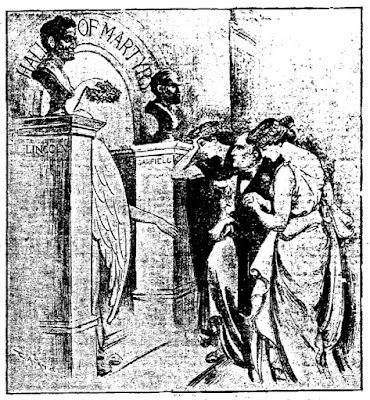The Assassination Tour, William McKinley's Last Days
On September 6, 1901 a pair of gunshots rang out at the Pan-American Exposition in Buffalo. The President of the United States collapsed and Polish anarchist named Leon Czolgosz was arrested for shooting the President. Over the next eight days people waited breathlessly, praying for the President's survival. Unfortunately, the bullet wounds, coupled with complications from an operation to remove one of the bullets which had lodged itself somewhere in the President's lower abdomen killed President McKinley on September 14, 1901. That afternoon Vice President Theodore Roosevelt came to Buffalo where Judge John R. Hazel swore him into the office of President.
The assassination of William McKinley led to widespread mourning as well as public outrage. On the day of McKinley's funeral the infrastructure of the entire country came to a halt for five minutes to mark the occasion. While many grieved, many more were angry at the ease with which Czolgosz carried out his crime. America had suffered its third assassination in 36 years and McKinley's death prompted Congress to authorize the Secret Service to act as full time guards to the president.
In Buffalo the assassination cast a pall over the Pan-American Exposition which continued for another two months and to this day Buffalo shares a morbid bond with Dallas and Washington D.C. as the only cities where an American President has been assassinated. Many of the sites crucial to understanding the assassination and its immediate aftermath are still standing and today I decided to create a guide for anyone interested in walking through the history of William McKinley's assassination at the hands of Leon Czolgosz.
Part I: The Assassination
William McKinley was assassinated inside the Temple of Music one of the many buildings erected for the Pan-American Exposition that was later torn down.1 After the Exposition buildings were torn down, the land was subdivided and sold to developers and prospective homeowners. The Parkside neighborhood developed over the exposition grounds and the historic tour begins in this neighborhood. Though the Temple's exact location will never be known, the Buffalo Historical Society placed a memorial rock at 30 Fordham Drive to commemorate the temple's approximate location.
The Temple of Music
Part II: The Assassin
Immediately after shooting President McKinley, a mob of enraged and vengeful people piled on top of Czolgosz and started to beat him senseless. Eventually police officers pulled Czolgosz out of the Temple of Music and moved to Police Precinct 13 at 346 Austin Street in Black Rock. Czolgosz's stay at Precinct 13 was brief. Within days he was moved to police headquarters and later to Auburn State Prison where he remained during his trial and where he was executed on October 29, 1901 by way of the electric chair.
The Police Precinct 13
Part III: The Operation, Convalescence, and Death of President McKinley
Immediately after being shot William McKinley was guided to a chair in the Temple of Music and from there conveyed to the Exposition's hospital building. Here two locals, Dr. Herman Mynter and Dr. Matthew Mann attempted to operate and remove the bullet that had penetrated McKinley's abdomen. The doctors worked in difficult conditions and had to reflect sunlight into the operating room to better see what they were doing. Further their attempts to probe for the bullet yielded nothing aside from the discovery of entry and exit wounds in McKinley's stomach which were sewn up. Following the surgery, President McKinley was moved to the home of John Milburn, the exposition's president. The house, sadly demolished in 1957, was located on Delaware Avenue near Canisius High School. McKinley spent the last eight days of his life in the house surrounded by doctors, friends, and his wife Ida McKinley.
The Milburn House
Part IV: The New President
During President McKinley's last days, Vice President Theodore Roosevelt was kept up to date on the President's health. Because McKinley appeared to be recovering, Roosevelt took a trip into the Adirondack Mountains. When word came of McKinley's death Roosevelt hurried to Buffalo taking a special train that had been ordered for him. Arriving in Buffalo, Roosevelt went to the home of Ansley Wilcox at 641 Delaware Avenue just a few blocks away from the Milburn House where McKinley had died hours earlier.
Theodore Roosevelt Inaugural Site
After Theodore Roosevelt's impromptu inauguration William McKinley's body was moved to Buffalo's city hall and from there to Washington D.C. Like Abraham Lincoln's body, McKinley's remains traveled by train from the capital back to his hometown, arriving in Canton, Ohio on September 19th. The country moved forward with Theodore Roosevelt as its president and though several of the critical sites related to the McKinley assassination have been lost, the event still looms large in the Queen City's history.
McKinley entering the Hall of Martyrs following his assassination






